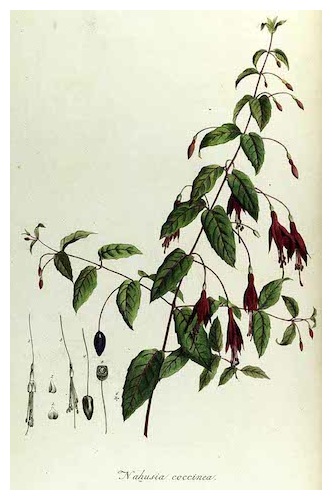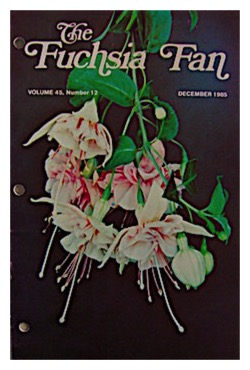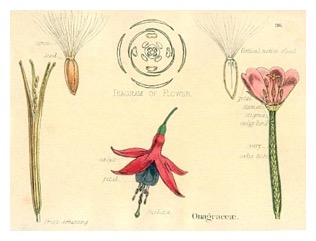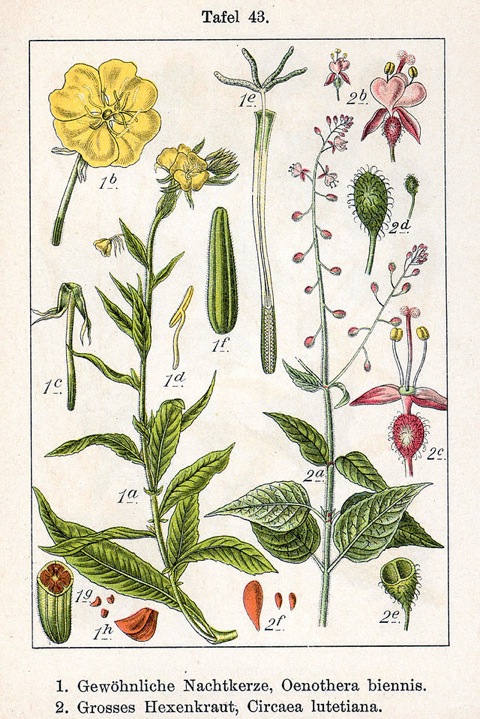
A Dictionary of the Fuchsia™
Want to know what those mysterious terms mean and just who the people were behind those names? Then this is the place for you.
Want to know what those mysterious terms mean and just who the people were behind those names? Then this is the place for you.

(Illustration: Nahusia coccinea in Icones plantarum variorum, 1793. Drawings by Hendrik Schwegman. Descriptions by George Voorhelm Schneevoogt.)
Nahuys, Alexander Petrus (1737-1794) – See Nahusia.
Nana – Small, dwarf. See F. nana in ➤ Section Hemsleyella.
National Collections (UK) – Over six hundred and fifty collections of living plants are designated as "National Collections" in the United Kingdom under a scheme of the National Council for the Conservation of Plants and Gardens due to their extent and importance (➤ Plant Heritage). For fuchsias there are the following eight collections: 1. ➤ Hardy Fuchsia, University of Leicester Botanic Garden; 2. ➤ Hardy Fuchsia, Kathleen Muncaster Fuchsias; 3. ➤ Fuchsias, Riverside Fuchsia and Pelargonium Nursery; 4. ➤ Fuchsia (Hardy Species & Cultivars), Silver Dale Nurseries; 5. ➤ Fuchsias (Hardy Species & Cultivars), Croxteth Hall and Country Park; 6. ➤ Fuchsia Cultivars Introduced by James Lye, James Lye Fuchsias; 7. ➤ Fuchsia sect. Quelusia, Harlow Carr; 8. ➤ Fuchsia Species, Jack Lamb.

Nectar - A sweet liquid secreted by flowers from the nectary. It's consumed by pollinators, such as hummingbirds or bees, who brush past pollen in one flower to deposit in another during their feeding.
Nectary – The glandular organ within a flower that secrets nectar.
Nectar Robbing – Some birds, including surprisingly some hummingbirds, and several kinds of bees will sometimes bore into the base of flower buds at the nectary to prematurely collect nectar just before the buds open. The odd phenomenon has been observed occurring on Fuchsia magellanica in the Tierra del Fuego, as well, and even been the subject of a scientific investigation into its possible effect on that species. Since the normal mutualism between plant and pollinator seems broken by the cheaters, scientists, including even Charles Darwin himself, have assumed that nectar robbing always had a negative impact on the affected plant species. However, a number of recent studies seem to indicate that the robbery usually has a generally neutral, or even a positive, effect on the reproductive strategies of plants. Other than a slight disfiguration from the small hole where the flower has been pierced, fuchsia nectar-robbing by hummingbirds or bees seems to have no discernible effect on the subsequent opening and fertility of fuchsia blossoms and fruit set.
Nelson, S. M. – California fuchsia breeder. Among his releases was the self-colored red Fuchsia 'Rufus', also known as 'Rufus the Red'. This hardy, upright classic was introduced in 1952.
Nigricans – Black. See F. nigricans in ➤ Section Fuchsia.
Nitid – Bright, lustrous or shining.
Node – The point of the stem at the leaf axil. Rooting in fuchsia cuttings will occur more rapidly from this point than from the internode so this fact should be taken into consideration when taking cuttings.
Nomenclature – The set of rules used to form the terms, such as the names of plants and animals, in any particular field of science. (For a good FAQ on current nomenclatural procedures within botany, see ➤ Mycologia.)
Northwest Fuchsia Society – Fuchsia society located in the Pacific Northwest region of the United States. There are a number of affiliated local branches and it publishes the Fuchsia Fan four times a year. The society hosted a national fuchsia convention, ➤ West Coast Wonders, in Seattle-Tacoma in 2008. See ➤ NWFS.
Notarisii – F. notarisii (Lehm. 1852) is now a synonym of F. microphylla (Kunth 1823).
Nothospecies – A hybrid species produced by crossing two species from the same genus, indicated by multiplication sign before the species epithet (for example Fuchsia x bacillaris). The parent species are often given in brackets.
Obconica – An inverted cone. See F. obconica in ➤ Section Encliandra.
Oblanceolate – Shaped with the top wider than the bottom. The term is applied to fuchsia leaves with this general outline.
Obovate – Teardrop-shaped. The term is applied to fuchsia leaves with this general outline.

It was this sexual system of plant identification that mislead the exiled Chilean botanist, Juan Ignacio Molina, to place F. magellanica into a new genus he called Thilco tinctorum in Saggio sulla storia naturale del Chili (1782). He followed Louis Feuillée's inaccurate drawing of a fuchsia with five petals and ten stamens done while he was traveling through Chile (Journal, 1714). To Molina's reasoning, Feuillée's plant clearly didn't belong under Octandria Monogynia with five petals but under Decandria Monogynia: It could therefore not be a Fuchsia. See Molina, Feuillée.
Oenothera –
Olivas Adobe – A California Historical Landmark (No. 115) and listed on the National Register of Historic Places in (1979), the Olivas Adobe was built in 1847 by Don Raymundo Olivas (d. 1879) in Ventura, California (then part of Mexico) on a large grant of secularized land that was originally part of the Mission San Buenaventura. Olivas had received the grant from the Presidio of Santa Barbara in 1841 in recognition of his services to Mexico.
Olivas’ wife—and some of their twenty-one children—continued to live here until 1899. The ranch was subsequently broken up and the house itself passed through several owners, including "Yeast King" Max Fleischman. It was donated to the City of Ventura as a museum in 1974.
The Adobe is said to be haunted by the ghost of a woman but its most important occupants are the ancient fuchsias in its front garden. The cultivar is Fuchsia ’Schiller' and they were planted in 1899 by Maria Olivas, the youngest daughter of the large Olivas family, just before the house was sold by the Olivas family in 1900. Two of Maria's plants survive and are the oldest-known continuously cultivated fuchsias recorded growing in the United States.
Onagra – A synonym of Oenothera L, the type genus of the Onagraceae, or Evening Primrose Family. Onagra is sometimes used as a common name. It's etymology is uncertain but it is possibly a reference to the onager, or wild ass, which supposedly preferred to eat evening primroses before it touched other plants.

This cosmopolitan and widely distributed plant family, of which Oenothera is the type species, contains approximately 640 to 650 species of herbs, shrubs, and trees divided into approximately twenty-three or twenty-four genera. The family is divided into two subfamilies, the Ludwigioidiae, which contains the single species Ludwigia, and the Onagroideae, further divided into six tribes. Along with the most closely related Circaea, Fuchsia is placed in the Circaeeae tribe within the Onagroidiae subfamily.
Onagraceae species are found on every continent (expect Antarctica) and range from boreal to tropical regions (except the arid regions of Australia and Africa). They are characterized by flowers usually with four sepals and four petals, generally pollinated by bees but also by hummingbirds and butterflies. The seeds are very small. In some genera, such as Epilobium, they have a tuft of down and are dispersed by the wind. In others, such as Fuchsia, the seeds are contained in a berry and are dispersed by birds. The leaves are most commonly opposite or whorled, spirally arranged in some species, and are generally simple and lanceolate in shape. Onagraceae pollen is easily differentiated from that of most other angiosperm families under the microscope, both from living plants and in the fossil record, by tetrads and the presence of sticky viscin threads.
On a final note, unlike genus and species, the botanical name of a family is never conventionally italicized. For example, Fuchsia regia subsp. reitzii (Onagraceae).

Ludwigia L
Subfamily Onagroideae
Tribe Circaeeae
Circaea L.
Fuchsia L.
Tribe Epilobieae
Chamerion Raf. ex Holub
Epilobium L. [Now includes Zauschneria Green]
Tribe Gongylocarpeae
Gongylocarpus Schltdl. & Cham.
Tribe Hauyeae
Hauya DC.
Tribe Lopezieae
Lopezia Cav.
Megacorax Elizondo et al
Tribe Onagreae
Camissonia Link
Camissoniopsis W.L.Wagner & Hoch
Chylismia (Torr. & A.Gray) Raim.
Chylismiella (Munz) W.L.Wagner & Hoch
Clarkia Pursh
Eremothera (P.H.Raven) W.L.Wagner & Hoch
Eucharidium Fisch. & C.A.Mey.
Eulobus Nutt. ex Torr. & A.Gray
Gayophytum A.Juss.
Neoholmgrenia W.L.Wagner & Hoch
Oenothera L. [Now includes Calylophus Spach and Gaura L.]
Taraxia (Torr. & A.Gray) Raim.
Tetrapteron (Munz) W.L. Wagner & Hoch
Xylonagra Donn.Sm. & Rose
(Illustration: 1. Plate from Illustration of the Principal Natural Orders of the Vegetable Kingdom, Walter Hood Fitch, 1874.; 2. Plate 43 illustrating Oenothera binennis and Circea lutetiana from Ernst H. L. Krause and Jacob Sturm. Flora von Deutschland in Abbildungen nach der Natur, 1901.)
Onagroideae – Along with Ludwigioideae, one of two subfamilies in the Onagraceae (see also). Fuchsia is a member species of this subfamily.
Opposite – Leaves that are arranged in pairs across from each other along a plant's stem. (See also Alternate.)
Orange County Fuchsia Society – A surviving branch of the defunct ➤ National Fuchsia Society in Southern California. The OCFS continues to host an annual plant sale.
Oregon Fuchsia Society – American fuchsia society established in 1944 and centered in Portland, Washington. The society hosted a national fuchsia convention, ➤ The Oregon Trail of Fuchsias, in 2010. See ➤ OFS.
Osgood, Wilfred (1875-1947) – Osgood was the assistant curator of mammalogy and ornithology from 1909 to 1921, and then curator of zoology from 1921 to 1940, at the Field Museum in Chicago. He also collected many plant specimens for the Museum on his expeditions. F. osgoodii, which he first collected, was named in his honor (Macbride 1941) but is now synonymous with F. andrei (Johnston 1925). See F. andrei in ➤ Section Fuchsia.
Osgoodii – Named in honor of Wilfred Osgood (1875-1947). F. osgoodii, described from a specimen which he collected, was named in his honor (Macbride 1941) but is now synonymous with F. andrei (Johnston 1925). See: Osgood; F. andrei in ➤ Section Fuchsia.
Orientalis – From the east. See F. orientalis in ➤ Section Fuchsia.
Ovalis – Oval. See F. ovalis in ➤ Section Fuchsia.
Ovary – The rounded part at the base of the stem which contains the ovules. After fertilization, it swells and encases the seeds.
Ovata – Ovate or egg-shaped. F. ovata (Moçino & Sessé ex DC. 1828) is a synonym of F. parviflora (Lindley 1827).
Ovate – Egg-shaped. The term is usually applied to fuchsia leaves with this general outline.
Ovule – The structure that develops into a seed after fertilization.





